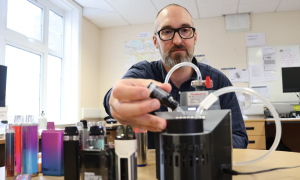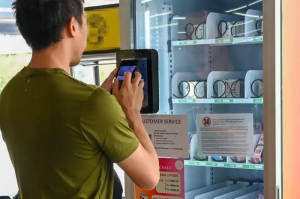- Richa Mukerjee, MSc
- Jana L. Hirschtick, PhD
- Luis Zavala Arciniega, MSc, MD
- Rafael Meza, PhD
- Nancy L. Fleischer, PhD
- Steven F. Cook, PhD
- Show all authors
Open Access Published: December 09, 2023DOI: https://doi.org/10.1016/j.amepre.2023.12.005
Introduction
ENDS use is highly prevalent among U.S. youth, and there is concern about its respiratory health effects. However, evidence from nationally representative longitudinal data is limited.
Methods
Using youth (aged 12–17 years) data from Waves 1–5 (2013–2019) of the Population Assessment of Tobacco and Health Study, multilevel Poisson regression models were estimated to examine the association between ENDS use; cigarettes; and diagnosed bronchitis, pneumonia, or chronic cough. Current product use was lagged by 1 wave and categorized as (1) never/noncurrent use, (2) exclusive cigarette use, (3) exclusive ENDS use, and (4) dual ENDS/cigarette use. Multivariable models adjusted for age, sex, race and ethnicity; parental education; asthma; BMI; cannabis use; secondhand smoke exposure; and household use of combustible products. Data analysis was conducted in 2022–2023.
Results
A total of 7.4% of respondents were diagnosed with bronchitis, pneumonia, or chronic cough at follow-up. In the multivariable model, exclusive cigarette use (incident rate ratio=1.85, 95% CI=1.29, 2.65), exclusive ENDS use (incident rate ratio=1.49, 95% CI=1.06, 2.08), and dual use (incident rate ratio=2.70, 95% CI=1.61, 3.50) were associated with a higher risk of diagnosed bronchitis, pneumonia, or chronic cough than never/noncurrent use.
Conclusions
These results suggest that ENDS and cigarettes, used exclusively or jointly, increased the risk of diagnosed bronchitis, pneumonia, or chronic cough among U.S. youth. However, dual use was associated with the highest risk. Targeted policies aimed at continuing to reduce cigarette smoking and ENDS use among youth, especially among those with dual use, are needed.
INTRODUCTION
ENDS use increased rapidly among U.S. youth between 2014 and 20181 and peaked in 2019,2 with 27% of high-school students and 10% of middle-school students reporting past 30-day ENDS use. 3
Although the prevalence of past 30-day ENDS use decreased to 14.1% among high-school students and 3.3% among middle-school students in 2022,4 its use remains highly prevalent among U.S. youth. Moreover, the dual use of ENDS with other tobacco products is an important public health problem5,6 because dual use has been associated with high levels of cigarette smoking intensity7 and nicotine dependence.7,8
The salience of ENDS use among youth has been accompanied by growing concerns about their respiratory health effects.9, 10, 11
Several prevalence studies have associated youth ENDS use with poor respiratory health,12, 13, 14, 15 but the cross-sectional design of these studies makes it difficult to establish temporality between ENDS use and respiratory health outcomes. Longitudinal studies help to mitigate these issues, but the longitudinal evidence has been mixed. For instance, using data from the Population Assessment of Tobacco Health (PATH) Study, youth ENDS use was not associated with an index of respiratory symptoms,16 wheezing,17 or incident diagnosed asthma.18,19
However, other longitudinal evidence suggests that ENDS use may increase the risk of poor respiratory health outcomes,9,10,20,21 particularly for bronchitis among youth.10,20
For instance, in a recent longitudinal sample of youth and young adults from Southern California, Tackett et al.20 found that ENDS use was associated with an increased risk of bronchitis and other respiratory symptoms. However, this association has yet to be examined with nationally representative longitudinal data.
The link between cigarette smoking and respiratory health symptoms among youth has been well established.22, 23, 24
Although the rates of youth cigarette use have declined precipitously in the past 20 years,25 dual cigarette and ENDS use (dual use) is both common26 and persistent27 among youth. Given that dual use has been associated with poorer respiratory health outcomes among adults than cigarette or ENDS use alone,9,28 it is important to understand whether dual use is associated with an increased risk of respiratory health symptoms among youth, who have tobacco use patterns different from that of adults.
This study examines the prospective association between exclusive and dual ENDS and cigarette use and recurrent bronchitis, pneumonia, or chronic cough among a nationally representative sample of U.S. youth. On the basis of the evidence reviewed, this study hypothesizes that (1) ENDS and cigarette use will be associated with an increased risk of incident bronchitis, pneumonia, or chronic cough among youth after adjusting for tobacco-related confounders and (2) the risk of incident bronchitis, pneumonia, or chronic cough will be highest among youth with dual use.
METHODS
Study Sample
This study used restricted-use youth data from Waves 1–5 (2013–2019) of the PATH survey, an ongoing nationally representative longitudinal study of tobacco use behaviors in the U.S.29
In Wave 1, a 4-stage stratified area probability sample design was used to recruit youth aged 12–17 years and a shadow sample of youth aged 9–11 years from the U.S. civilian non-institutionalized population. In Wave 4, a nationally representative replenishment sample of youth and shadow youth aged 10–11 years was added. Finally, a special wave of data was collected during Wave 4.5, which was specific to youth aged 12–17 years. Additional details about the PATH Study design are available elsewhere.30
Further details on how to access the restricted-use data are described in the PATH Study Restricted-Use Files User Guide (available at https://doi.org/10.3886/ICPSR36231.v33).
The analytic sample for this study consisted of 17,517 participants aged between 12 and 17 years at follow-up interview (Waves 2–5) who completed an interview in the previous wave (Waves 1–4.5; 43,290 observations). This includes youth from the Wave 1 cohort, the Wave 4 replenishment sample, Wave 4.5, and shadow youth who aged into the youth sample. Each respondent’s first interview was considered their baseline wave. That is, Wave 1 was the baseline wave for the youth cohort, Wave 4 and Wave 4.5 were the baseline waves for youth in these respective samples, and the baseline wave for the shadow youth was the wave in which they aged up into the youth cohort (Waves 2–4). A flowchart of the analytic sample can be found in Appendix Figure 1 (available online). Given that secondary, deidentified data were used, this study was not classified as regulated human subjects research by the University of Michigan IRB.
Measures
Parent-reported bronchitis, pneumonia, or chronic cough was based on the following question, In the past 12 months, has (Child’s first name) been told by a doctor, nurse or other health professional that (he/she) has bronchitis, pneumonia, or chronic cough? This outcome was measured at each wave, and youth whose parents responded yes to this question were considered to have had bronchitis, pneumonia, or chronic cough (no/yes). The main analysis allowed for recurrent outcomes, meaning that youth could experience the outcome more than once.
Current cigarette use was defined as having smoked cigarettes on at least 1 day in the past 30 days, using the question, In the past 30 days, on how many days did you smoke cigarettes? Similarly, current ENDS use was defined as having used ENDS products at least 1 day in the past 30 days using the question, In the past 30 days, on how many days did you use an e-cigarette/electronic nicotine product? These 2 variables were then used to construct a 4-category, time-varying exposure: (1) never or noncurrent use of ENDS or cigarettes, (2) exclusive cigarette use, (3) exclusive ENDS use, and (4) dual use of cigarettes and ENDS. The tobacco use exposure was lagged by 1 wave to ensure that it preceded the outcome in the follow-up waves.
Race and ethnicity (non-Hispanic [NH] White, NH Black, Hispanic, another race/ethnicity), sex (male, female), and parental education (less than high school, high school or GED, some college, bachelor’s degree or higher) were included as baseline demographic covariates, whereas age was included as a time-varying demographic covariate. BMI (BMI percentile under 85, underweight or normal weight; BMI percentile 85–94, overweight; BMI percentile ≥95, obesity),11 asthma (no/yes), past 7-day secondhand smoke exposure (measured in hours), current use of combustible tobacco products (namely cigarettes and cigars) by another household member (no/yes), and cannabis use (no/yes) were included as baseline risk factors.
Statistical Analysis
Weighted descriptive statistics were calculated for all variables at baseline, and the prevalence of tobacco use exposure was calculated at each wave. Next, the tobacco use exposure was examined according to the frequency of ENDS use and intensity of cigarette use at each wave, and chi-square tests or Fischer’s exact tests were used to test for statistical differences between groups in the exposure. Finally, the longitudinal associations between exclusive and dual ENDS and cigarette use and diagnosed bronchitis, pneumonia, or chronic cough at follow-up were assessed using multilevel Poisson regression models across 5 time periods (Waves 1–2, Waves 2–3, Waves 3–4, Waves 4–4.5, Waves 4.5–5).
This multilevel modeling approach is commonly used to examine the impact of time-varying exposures and repeated measured outcomes while controlling for interdependence of observations contributed by the same individuals.31
PATH’s cross-sectional weights were recalibrated into 2-level weights to accommodate the longitudinal structure of the data set.32
The Level 1 weights were conditional wave-specific weights that were scaled so that their sum equaled the number of data points available for each respondent across waves. The Level 2 weights were respondent-specific weights and represented by PATH baseline survey weights, where baseline refers to the wave in which an individual entered the youth cohort. All analyses were conducted using STATA 17.1.
Several sensitivity analyses were conducted. First, to assess potential confounding from including participants with a baseline diagnosis of asthma in the analytic sample, multilevel models were estimated excluding these participants. Second, to limit concern that participants who had already experienced the outcome at baseline may be biasing the results, multilevel models were estimated excluding participants with a baseline diagnosis of bronchitis, pneumonia, or chronic cough from the analytic sample. Finally, because it was possible that participants who experienced the event more than 1 time were biasing the results, multilevel models were estimated excluding the recurrent events.
RESULTS
Baseline sociodemographic characteristics and risk factors are presented in Table 1. About half of respondents were male (51.5%) and NH White (53.0%), whereas 39.2% reported a parental education of bachelor’s degree or higher. The majority of the sample had a BMI in the underweight or normal weight range (64.7%), whereas 18.3% were classified as overweight, and 17.0% were classified as obese. In Wave 1 (n=8,692), 60.5% were aged 12–14 years (Appendix Table 1, available online), with a similar age breakdown in subsequent waves. In terms of tobacco product exposure at baseline, 6.4% reported ever use of cannabis, and approximately one quarter (26.5%) reported that a household member used combustible products at baseline, whereas the average secondhand smoke exposure was 0.3 hours per every 10 hours during the 7 days preceding the baseline survey (Table 1). Finally, 7.4% of respondents reported a diagnosis of bronchitis, pneumonia, or chronic cough in at least 1 wave between Waves 2 and 5 (Table 2).










